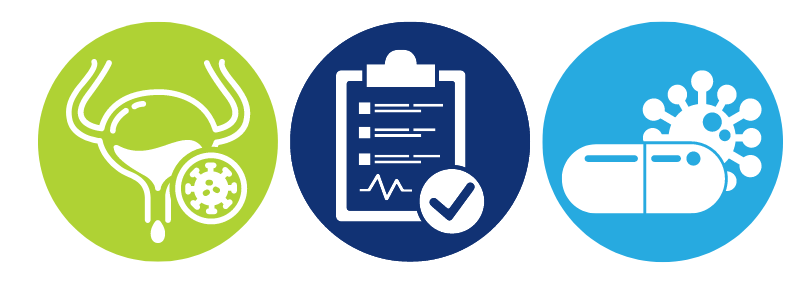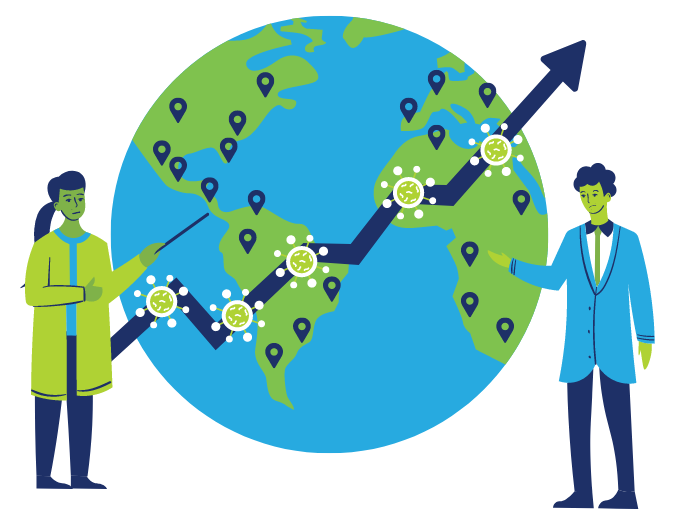
Three full years into the COVID-19 pandemic and the world still doesn’t have a firm answer about where the virus came from.
People who have been studying coronaviruses and other viruses for decades say it’s overwhelmingly likely the SARS-CoV-2 virus came from animals, just as the 2002-2004 SARS virus did, the Middle East Respiratory Syndrome or MERS virus did, as Ebola does, and as most influenza viruses do.
But there’s no smoking gun- no animal being sold for food that carries the virus and that could conceivably have been the source of the pandemic. And that makes people suspicious and leads to speculation that a laboratory leak from the Wuhan Institute of Virology in China could have been the source.
Dr. Felicia Goodrum, professor of immunobiology at the University of Arizona and co-editor-in-chief of the Journal of Virology, argues that the tone of the current debate is harmful and undermines trust in science.
“The result has fueled public confusion and, in many instances, ill-informed condemnation of virology. With this article, we seek to promote a return to rational discourse,” she and colleagues wrote in a recent commentary in the Journal of Virology.
“COVID-19 has cast a harsh light on the many cracks, fissures, and disparities in our public health system, and the inability to broadly come together to face a colossal crisis and focus on the needs of the most vulnerable,” they wrote.
Listen as Dr. Goodrum tells One World, One Health host Maggie Fox about what’s at stake.
Maggie Fox (0:01)
Hello and welcome to One World, One Health with the latest ideas to improve the health of our planet and its people. I’m Maggie Fox.
Planet Earth faces problems such as pollution and climate change in new and reemerging infectious diseases, and they are all linked. This podcast is brought to you by the One Health Trust with bite-sized insights into ways to help.
The entire world is still seeing firsthand how closely all of these problems are linked with the ongoing COVID-19 pandemic. It’s a virus that originated in animals and has spread to people. In this episode, we’re chatting with Dr. Felicia Goodrum, professor of Immunobiology at the University of Arizona and co-editor in chief of the Journal of Virology. She’s taken a strong interest in how important research has been to detecting, fighting and studying the pandemic and how important the field of virology will be to helping prepare for the next one.
Felicia, thanks so much for joining us.
Felicia Goodrum (1:00)
Thanks, Maggie. I’m really delighted to be here.
Maggie Fox (1:02)
There’s been a lot of discussion lately about where COVID came from. Before we dive into that, let’s talk about where other coronaviruses are known to have come from. I’m thinking, SARS in 2002 and the Middle East Respiratory Syndrome virus or MERS.
Felicia Goodrum (1:18)
Right, and those, of course, are really important viruses to understand for a number of reasons. A: They are predecessors and cousins that we can really understand and the work that was done on them for decades really laid the foundation for the work that allowed for the rapid development of vaccines and antivirals for SARS-CoV-2. So what we know about these viruses is that, like most viruses, they emerge into the human population through a zoonosis event, which is a jump from animals into humans that then acquires a sustained spread, human-to-human.
That actually is a fairly rare event. We think that zoonosis often will jump, or occur, to allow a virus to jump into humans, but then that’s a dead end and it can’t actually replicate in the human or it can’t spread human-to-human. But in the case of SARS-CoV-2, of course, that happened. With SARS and MERS, that also happened, but the ability of that virus to spread was much more confined than for SARS-CoV-2.
Maggie Fox (2:13)
Can you tell us a little bit about how we know that the first SARS and MERS came from animals into people and didn’t occur in some other way?
Felicia Goodrum (2:23)
A lot of this comes from the sequencing that is done to gather information prior to an outbreak. I mean, this really needs to happen rather agnostically prior to an outbreak. We are surveilling the viruses that are circulating among populations of animals, especially those that are likely to give rise to zoonoses. That often includes bats.
Sometimes viruses will enter into another animal that serves as an intermediate, coming from bats into another animal, that then will jump into humans. So, we really have to know what viruses are out there and circulating and this is work that requires decades and decades of collecting and cataloguing and seeing how viruses are changing and moving throughout populations.
Maggie Fox (3:07)
And with both the original SARS and the current SARS, there’s very strong evidence that bats are the original reservoir of the viruses.
Felicia Goodrum (3:17)
Exactly.
Maggie Fox (3:18)
And you could tell that by looking at the genetic sequence?
Felicia Goodrum (3:17)
The genetic sequence, right. Often when a zoonosis happens, you’re never going to find the exact animal that was the reservoir. That is the case currently with SARS-CoV-2, is that we do not have an animal that has that exact sequence for SARS-CoV-2.
Maggie Fox (3:25)
And that has fed all of these conspiracy theories, right? Not being able to find the smoking gun. With the original SARS, it was pretty clear. It was an animal that was being eaten by people living in Southeast Asia. It’s pretty clear that’s where it came from. But not this one. We don’t have that intermediate animal and that’s what’s making people confused.
Felicia Goodrum (3:58)
That’s right. But it is very common that we never find that intermediate animal. In the case of SARS-CoV-2, while sequences have been found in the seafood market where SARS seems to have made its jump into humans, the exact animal hasn’t been found, and that’s because those animals are now long gone following the pandemic. This is another place where surveillance of genomes that are out there and circulating is really important to happen prior to the outbreak because it’s really the only way you find what has really caused that outbreak often.
Maggie Fox (4:33)
That’s one of the problems. Some politicians have expressed concern about this kind of laboratory research looking at what the virus would look like if it was something that could live in bats, jump to another animal, jump to people and then survive in people for more than one or two generations so it could spread. Each one of those leaps requires a genetic change. And what you’re saying is that scientists need to understand that process ahead of time?
Felicia Goodrum (5:02)
Yes, absolutely.
Maggie Fox (5:04)
But it confuses people because they’re like, well, the scientists are cooking up “Frankenviruses” in the lab.
Felicia Goodrum (5:09)
That is the concern and it’s a little bit misdirected of a concern because laboratory research has always been surrounded by a lot of safety considerations. Biosafety is paramount. It’s the first thing a student learns when they enter a virology lab, is the importance of safety to protect the people working with the virus, but also the greater population. A very small fraction of research, a very, very, very small fraction of research, actually is conducted that could result in one of these sort of “Frankenviruses” as you refer to and that research has given really intense oversight at the federal level.
There’s a lot of structures in place, both at local institutions, all the way up through the federal government, where there’s research to make sure that what’s being done and the experiments being conducted are in the best interests of science and understanding, for example, how viruses spread and not posing that heightened risk.
Maggie Fox (6:06)
And this research is known commonly as gain of function research. That’s a term that’s getting thrown around. And then there are some other terms that are a bit more precise, can you walk us through some of that language?
Felicia Goodrum (6:19)
Sure. Well, gain of function is a very powerful genetic tool. In all of genetics, most simply put: 50% of it will be loss of function, which we learn a lot from, and 50% is going to be gain of function. And gain of function really encompasses anything where you have made a genetic change in a pathogen that now has gained an additional function. This could be something sort of as benign or simple as engineering a fluorescent marker into that pathogen so that you can follow its transmission through a dish of cultured cells, or it can be much more complex. I think where the worry has stemmed from is that it could incorporate changes that make it more transmissible, for example, or increased pathogenesis, and that is the research that gets the highest level of scrutiny and oversight in the United States.
Maggie Fox (7:09)
Let’s go back just a little bit and explain to people about these genetic changes because viruses mutate constantly, some more than others. Can we explain a little bit about how some of these mutations make the virus more fit and more able to live in its host, in this case, we’re concerned about a human? Some of the changes make the virus just die out.
Felicia Goodrum (7:28)
Viruses do constantly mutate. So they’re doing their own experiments out there in nature. And certainly, as they are moving from different host species, they’re having to acquire changes. That is essentially a gain of function event, when a virus makes mutations that allows it to jump into another host and actually replicate. There’s a lot of barriers to viruses jumping species, because viruses have evolved to really be able to work with the system that they find within the cells of a particular species.
So jumping from species to species, there are a lot of barriers to that, and it is a gain of function when a virus does that. Scientists are studying these viruses. This is what we really need to understand, in order to develop effective vaccines and antivirals. We need to understand how viruses are changing [and] how they’re acquiring these functions, so that we’re ready to respond when one has pandemic potential.
Maggie Fox (8:27)
So what’s the harm in having the debate over whether this was going on in a lab in Wuhan, or anywhere else? Isn’t this something people should be aware of?
Felicia Goodrum (8:37)
Absolutely. And there’s no harm in having a debate. The question was posed a number of years ago now, during the pandemic of, “We need to understand these origins.” Understanding where pandemics come from is a very, very important question. But now, years later, there is a lot of evidence that has been accumulated over time by scientists all over the world studying this pandemic. I’m not one of those scientists, just for clarification. I study a DNA virus so I really stay out of the spray. But as a virologist, I know how to understand the data [and] how to evaluate the data. I feel like in that way, I can be an advocate for the work going on when I don’t actually have skin in the game.
This work is really important and what it has yielded is a lot of evidence for a zoonotic origin to SARS-CoV-2. What we do not have evidence for is the alternate hypothesis that it came from a laboratory leak. So with the evidence, we went from two plausible hypotheses early in the pandemic to now one that is very strongly supported by the data and the evidence that exists.
Maggie Fox (9:43)
You’ve pointed this out in the Journal of Virology in a commentary. When people hear of a lab leak, they think of a human-engineered virus meant to be scary. But there could be a different kind of lab leak that is a little less nefarious. And I suppose you could be studying a naturally occurring virus, you could have some bats in cages that were infected. And that could be a lab leak as well. It’s not necessarily some kind of engineered virus.
Felicia Goodrum (10:10)
Exactly.
Maggie Fox (10:11)
Government oversight is supposed to make sure that care is taken that these viruses don’t escape and don’t infect the lab workers.
Felicia Goodrum (10:19)
Yes. And that care and oversight is there, from the level of the individual, the individual institution, all the way up through the federal government.
Maggie Fox (10:28)
But there are accusations that even though this oversight was supposed to exist, the Wuhan Institute of Virology did not, in fact, exercise that oversight carefully enough.
Felicia Goodrum (10:39)
Yes, that’s the concern. And I think it’s a reasonable concern, and something that needs to be there. We lack a little transparency there to actually know everything that was happening and that’s a huge problem. But the truth of the matter is, what cannot be refuted, is that despite that being a plausible hypothesis, the data and evidence that has been collected, that has emerged over the past two years very clearly falls in the camp of supporting the hypothesis that it was a zoonotic origin. So therefore, despite the concern and the lack of transparency that has existed, the data that we currently have supports the zoonotic hypothesis.
Maggie Fox (11:21)
When you say lack of transparency, what you’re saying is that the Chinese government hasn’t really given enough information about what did or didn’t happen.
Felicia Goodrum (11:29)
Yes.
Maggie Fox (11:30)
All of this mistrust — how does it hurt the possibility of international cooperation? This is One Health, right? What happens in China affects what happens in the US. And this mistrust has got to be damaging any kind of work towards international cooperation on that level.
Felicia Goodrum (11:48)
This is where I see just the infinite risk. Viruses know no boundaries, as we learned very, very well in this pandemic, and so where they emerge, they’re going to easily be able to affect us here. And what it takes is a global collaboration and global partnerships to be able to respond. We need transparency between governments and we need collaboration and connection and networking between scientists so that people are in conversation about what’s happening about strange pneumonias that are popping up in hospitals, sequence data needs to be shared so that we can actually very quickly develop the antivirals and the vaccines.
If we did not have really strong partnerships with China, for example, we would not be able to prepare for the seasonal flu that we’re going to see every single year. So how do we do that? And how do we protect our citizens if we don’t have these global collaborations? While science across the world needs to be conducted with rigor and safety, we need to be able to ensure that but also ensure that we are working together as a world to protect from these sorts of challenges because these challenges are increasing with climate change and habitat destruction, increased urbanization, as we are interfacing more and more with animal populations that we have not previously interfaced with, and we have cities with very dense populations.
We are primed for these sorts of emergence events. In the last 100 years, there’s been a virus that has emerged with the potential to cause an epidemic or pandemic at least every 10 years. But in the last, say, three to five years, there have been three. This is increasing because of climate change and habitat destruction, the way people are living and the industrialization of farming practices. And it’s not just about human health. Can you imagine a virus that emerges that wipes out all poultry or all pork or all corn or all rice? This would be devastating to the human population. It is very much a One Health issue, and it is very much an issue where we must have global partnerships.
Maggie Fox (13:55)
Felicia, thank you so very much for spending this time with us.
Felicia Goodrum (13:59)
Great. I’m so happy to be here. Thank you, Maggie.
Maggie Fox (14:03)
If you liked this podcast, which is brought to you by the One Health Trust, please share it by email, LinkedIn or your favorite social media platform. And let us know what else you’d like to hear about at [email protected]. Thanks for listening.
Ramanan Laxminarayan (14:21)
Thank you for listening to One World, One Health brought to you by the One Health Trust. I’m Ramanan Laxminarayan, Founder and President of the One Health Trust. You can subscribe to One World, One Health on Spotify, Apple Podcasts, or wherever you listen to podcasts. Follow us on social media at OneHealthTrust for updates on One World, One Health and the latest research on One Health issues like drug resistance, disease spillovers and the social determinants of health.
Finally, please do consider donating to the One Health Trust to support this podcast and other initiatives and research that help us promote health and well-being worldwide. Until next time!
Guest

Dr. Felicia Goodrum is the Associate Department Head and a Professor in the Department of Immunobiology at the University of Arizona. She is the former President of the American Society for Virology and is the Co-Editor in Chief of the Journal of Virology. She received her Ph.D. from Wake Forest University School of Medicine and completed her postdoctoral training at Princeton University before joining the faculty at the University of Arizona. Her work on understanding complex virus-host interactions that define the mechanisms by which DNA viruses persist in the host by way of a latent infection has been recognized through the Howard Temin Award, the Pew Scholar in Biomedical Sciences Award, Kavli Young Investigators Award, and the Presidential Award for Early Career Scientists and Engineers.
Credits
Hosted and written by Maggie Fox
Special guest: Felicia Goodrum
Produced and edited by Samantha Serrano
Music composed and sound edited by Raquel Krügel
Transcript edited by Harsh Pingle and Aditi Satyavrath







